The Setting Sun - Gotterdammerung, Japan 1944.
- Thread starter unmerged(59906)
- Start date
-
We have updated our Community Code of Conduct. Please read through the new rules for the forum that are an integral part of Paradox Interactive’s User Agreement.
You are using an out of date browser. It may not display this or other websites correctly.
You should upgrade or use an alternative browser.
You should upgrade or use an alternative browser.
Haven't seen the Yamato for sometime now, good thing you are getting carriers out of the way for it.
It also seems the British are stating to realize the extent of their situation.
Good update.
It also seems the British are stating to realize the extent of their situation.
Good update.
My god... How could I have missed another Remble aar?!
*subscribed*
I cant miss it keep up the good work!!
keep up the good work!!
*subscribed*
I cant miss it
Deus - Seemed strange that FDR died. A lot of the forces in Burma are American controlled by the British and so are harder to kill. Some of the enemy forces in India are from all over the World including Canada and Brazil.
TheHyphenated1, Murmurandus, dolgorouki - Thank you
thatguy - Unfortunately the next level of Naval bomber is a turbojet and I can't even research this technology yet. I won't be building any more of them either as they are just too good at their job.
Sokraates - Fleet flagships are always the first ship of that type that is added to a fleet regardless of it being Human or AI controlled. The Burmese landing is in the next update.
Striker475 - A map will be in the next update. April is a little earlier than I would like for the Soviets. July or August would be very nice.
Kanil - As Thurak pointed out, yes they are dangerous. I would need to outnumber them probably by 2:1 to win convincingly.
Thurak - At the moment there are no repairs going on but that changes in the next update.
Ektoras - Thanks. My big ships will be at sea soon enough, its not like they are chasing other big ships after all.
OneArmed - Thank you. For an AAR I play on below normal to make sure I can pause every hour easily enough so that I don't miss anything. Of course this would be different if I was playing an earlier scenario where things are a lot quieter. Like a lot of people I use very fast for early years in 1936 for example.
Nathan Madien - I expect the change of Head of State won't alter the way its uses the USN, you are correct there
germanpeon - Successfully sinking a lot of ships in a naval engagement is a little more satisfying but not likely to happen
Maj. von Mauser - Thank you. The British are in some trouble certainly. India is a wide open plain where bombing is easy for the most part and my defence has been chosen to allow my bombers the easiest targets it can find.
Raaritsgozilla - You haven't missed it your just a bit late finding it
Update to follow ...
TheHyphenated1, Murmurandus, dolgorouki - Thank you
thatguy - Unfortunately the next level of Naval bomber is a turbojet and I can't even research this technology yet. I won't be building any more of them either as they are just too good at their job.
Sokraates - Fleet flagships are always the first ship of that type that is added to a fleet regardless of it being Human or AI controlled. The Burmese landing is in the next update.
Striker475 - A map will be in the next update. April is a little earlier than I would like for the Soviets. July or August would be very nice.
Kanil - As Thurak pointed out, yes they are dangerous. I would need to outnumber them probably by 2:1 to win convincingly.
Thurak - At the moment there are no repairs going on but that changes in the next update.
Ektoras - Thanks. My big ships will be at sea soon enough, its not like they are chasing other big ships after all.
OneArmed - Thank you. For an AAR I play on below normal to make sure I can pause every hour easily enough so that I don't miss anything. Of course this would be different if I was playing an earlier scenario where things are a lot quieter. Like a lot of people I use very fast for early years in 1936 for example.
Nathan Madien - I expect the change of Head of State won't alter the way its uses the USN, you are correct there
germanpeon - Successfully sinking a lot of ships in a naval engagement is a little more satisfying but not likely to happen
Maj. von Mauser - Thank you. The British are in some trouble certainly. India is a wide open plain where bombing is easy for the most part and my defence has been chosen to allow my bombers the easiest targets it can find.
Raaritsgozilla - You haven't missed it your just a bit late finding it
Update to follow ...
Operation Dilemma
9
0500 January 14th 1945.
BB Division 1 Flagship. IJN Yamashiro, Gulf of Martapan.
Spruance had lost a Destroyer Division to add to the already sunk USS Bon Homme Richard and he decided to leave the North Mariana Trench.
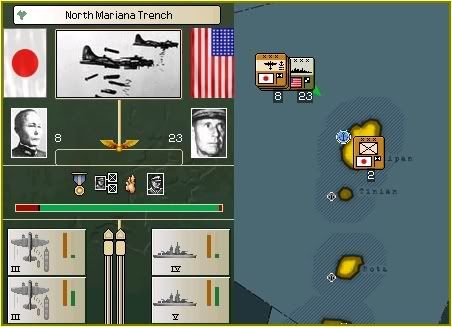
Ozawa would try and cause as much damage as he could before Spruance could leave. Admiral Mikawa could now move the extra defensive troops to Guam and Saipan in relative safety.

Enemy fleet interceptions continued to be high as BB Division 2 caught a small United States Navy fleet south of Indonesia. The Battleship IJN Fuso would sink the Light Cruiser USS Duluth and IJN Nagato the 9th Destroyer Division.
1400 January 24th 1945.
North China Army Headquarters. Jinghong, China.
Allied troops, which were in fact American although they were British controlled, had arrived in Chittagong.

Stillwell tried to advance into Comilla but was easily halted by the three defending Japanese infantry divisions. Bombers were busy throughout Burma and Siam as Higashikuni increased the pressure on the defensive forces in the area.
The Japanese invasion fleet was loitering off the Burmese coast waiting for the correct moment to attempt an amphibious assault.
The Japanese invasion fleet was loitering off the Burmese coast waiting for the correct moment to attempt an amphibious assault.
1900 January 14th 1945.
BB Division 1 Flagship. IJN Yamashiro, Gulf of Martapan.
Admiral Mikawa had arrived in Guam and deposited an extra infantry division to bolster the islands defences.
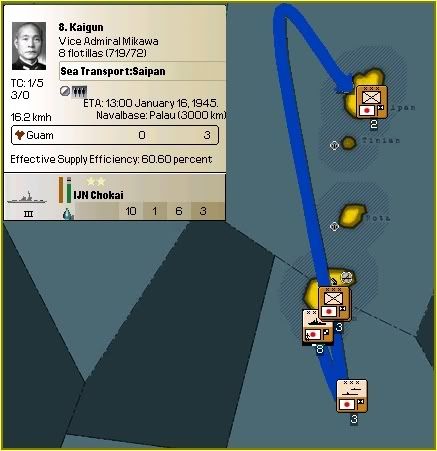
He set sail immediately for Saipan to conclude his mission. This area was not particularly safe for a Japanese Transport fleet and the sooner he was done the quicker he could head into safer waters.
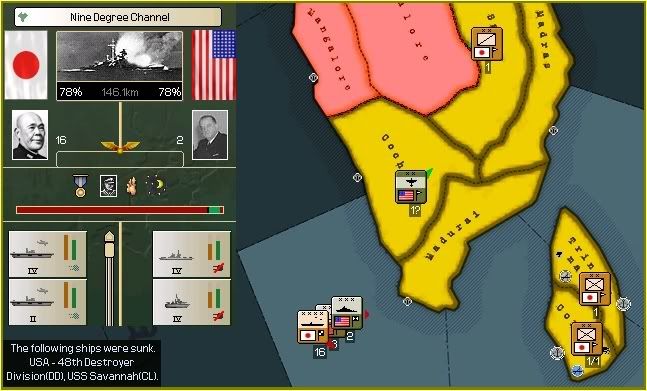
Nagano had Carrier Group C operating all around the southern tip of India and was finding no shortage of enemy contacts wherever he happened to be.
The Carrier IJN Ryuho would sink the Light Cruiser USS Savannah and IJN Zuikaku the 48th Destroyer Division.
Mikawa's Transport fleet was attacked in the South Mariana Trench by an enemy fleet as he tried to reach Saipan.
The Carrier IJN Ryuho would sink the Light Cruiser USS Savannah and IJN Zuikaku the 48th Destroyer Division.
Mikawa's Transport fleet was attacked in the South Mariana Trench by an enemy fleet as he tried to reach Saipan.

The Heavy Cruisers failed to protect either the Transport ships or the Submarines defending the sea lanes. Two fairly modern American Destroyer Divisions managed to outwit the Japanese captains and sink two Submarine Flotillas during the battle. The 39th and 37th Destroyer Divisions would sink the 16th and 15th. Sensuikantai respectively.
It would fall to the Naval bombers to extract revenge as Mikawa continued north to reinforce Saipan. The 37th Destroyer Division would sink before it could leave the area.
It would fall to the Naval bombers to extract revenge as Mikawa continued north to reinforce Saipan. The 37th Destroyer Division would sink before it could leave the area.
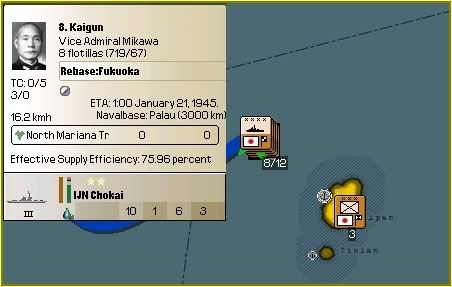
By 0500 hours on January 17th Mikawa had finished his mission and the main Marianas islands were looking considerably better defended. He led his Transport fleet towards Fukuoka where it would join with the former German Transport fleet already in the port.

Two more American Destroyer Divisions, this time even more modern, where encountered in the North Mariana Trench. The Submarines managed to evade the enemy ships and make it safely into Saipan harbour, leaving Ozawa to deal with the dangerous anti-Submarine ships.
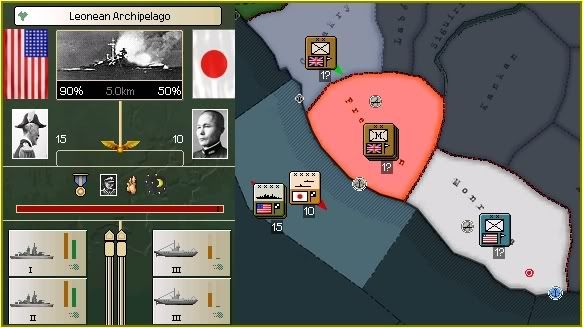
Yamamoto received an update from the last Submarine fleet trying to make it safely to Japan. It had been intercepted by a large American Battlefleet off the coast of Freetown. Some minor damage resulted but the Submarines managed to evade any further destruction as they continued their journey towards safety.
0000 January 18th 1945.
Industry Offices. Tokyo, Japan.

0000 January 19th 1945.
North China Army Headquarters. Jinghong, China.
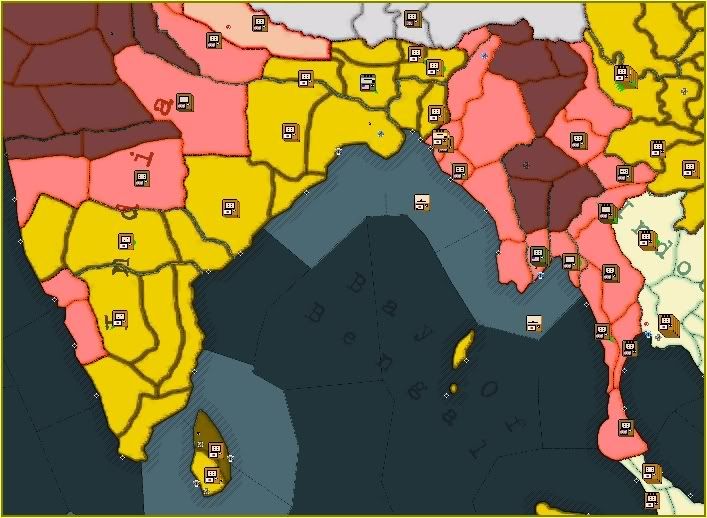
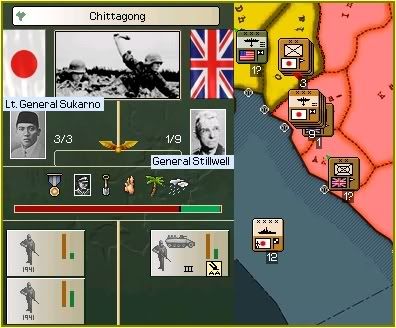
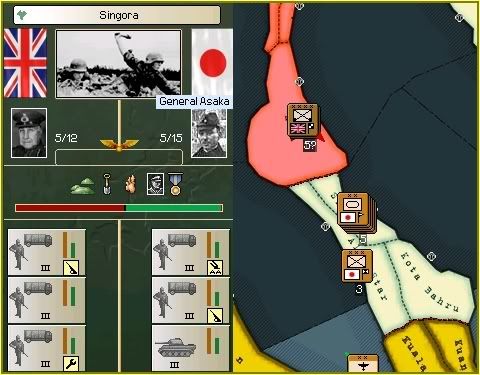
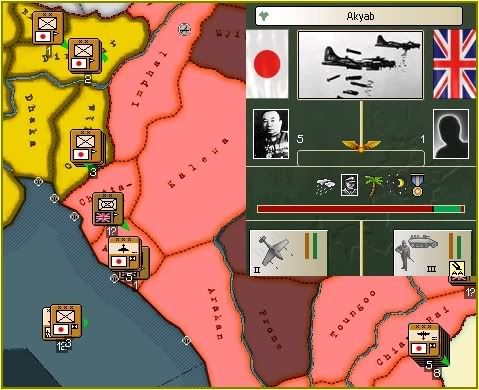
0500 January 21st 1945.
BB Division 1 Flagship. IJN Yamashiro, Gulf of Martapan.
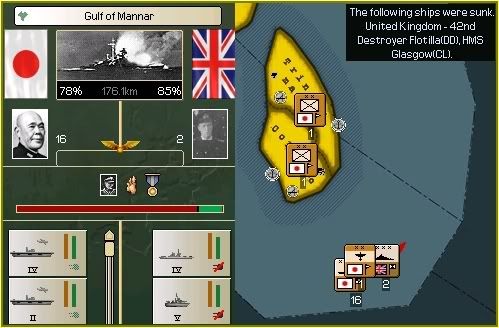
0500 January 21st 1945.
North China Army Headquarters. Jinghong, China.
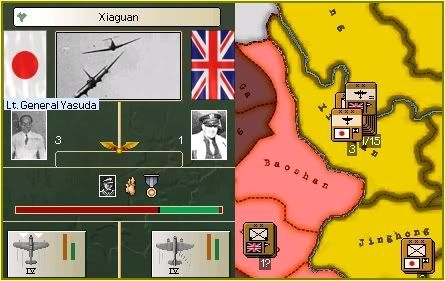

Industry Offices. Tokyo, Japan.
Ginjiro had altered Japanese production a few days earlier to increase the speed at which the dissent was reduced. Some small delays would result in production but the lack of repairs was becoming a concern and needed to be addressed.

With the dissent reduced to zero he was able to begin the construction of additional Convoy and Escort ships as well as allow repairs to Japanese Armed Forces. Spare factory output would remain scarce for a few more months to come but things were slowly improving.
0000 January 19th 1945.
North China Army Headquarters. Jinghong, China.
Higashikuni looked over his map of the main area of operations where his forces were currently engaged. He was satisfied with overall progress.

The cavalry divisions that had been sent to southern India had captured a large amount of territory as there were no defenders present.
Elsewhere progress was predictably slow with only a small advance into north western Burma evident so far.
Elsewhere progress was predictably slow with only a small advance into north western Burma evident so far.

At 0100 hours General Stillwell's previous failed attack on Comilla returned to haunt him as Sukarno launched his own attack towards Chittagong. The support of Japanese bombers would make this an easy victory.

In the south Wilson tried again against Singora. General Asaka easily held of the British forces on this occasion. No counter attack would be forthcoming for the time being with Japanese bombers too busy elsewhere.

Having removed the enemy divisions in Baoshan Japanese Dive bombers were free to hunt other prey in Northern Burma. They targetted the second mechanised division heading along the north west coast of Burma.
The Japanese invasion had also began as three infantry divisions began heading for the mountainous coastal province of Arakan. Should this be successful it would leave the British troops to the north in a very dangerous situation. The invading troops would also be under some threat but the Transport fleet would remain in the area for a few hours in case they came under heavy attack and needed to withdraw.
The Japanese invasion had also began as three infantry divisions began heading for the mountainous coastal province of Arakan. Should this be successful it would leave the British troops to the north in a very dangerous situation. The invading troops would also be under some threat but the Transport fleet would remain in the area for a few hours in case they came under heavy attack and needed to withdraw.
0500 January 21st 1945.
BB Division 1 Flagship. IJN Yamashiro, Gulf of Martapan.
Carrier Group C had found another small fleet, this time it was British. Enemy Transport ships were becoming harder to find as the month wore on.

The 42nd Destroyer Flotilla and the Light Cruiser HMS Glasgow would be sunk by aircraft from IJN Zuikaku.
0500 January 21st 1945.
North China Army Headquarters. Jinghong, China.
Enemy bombers had started to harass the advancing Japanese troops in northern Burma. Interceptors were scambled to deal with the problem.

Lt. General Yasuda, and his three squadron interceptor wing, easily dealt with the single Tactical bomber they encountered over Xiaguan.

At 2100 hours on January 21st Lt. General Iida landed successfully in Arakan behind the British rear lines. The only real threat to his defences was the enemy force in Rangoon which would need to attack him across a river if it chose to do so. The mountains would be a good area to defend should it be needed.
Man, what is up the the lackluster performance of your subs?
I think their commander may need a dressing down.
Nice update otherwise.
I think their commander may need a dressing down.
Nice update otherwise.
another landing in Burma, good luck. your Rares are getting smaller. what do you think for the future resource problems? 3 months later ... will the resources of India be enough for you?
and your TC is getting worse and worse... and just like your Germany AAR, you don`t think to liberate any country, right? so, you need lots of Garrisons and your manpower is enough but IC isn`t. i hope Russkies keep quiet a little bit more to let you solve your TC problem. i hope they don`t attack nowadays but i believe you can find a way to get through
and your TC is getting worse and worse... and just like your Germany AAR, you don`t think to liberate any country, right? so, you need lots of Garrisons and your manpower is enough but IC isn`t. i hope Russkies keep quiet a little bit more to let you solve your TC problem. i hope they don`t attack nowadays but i believe you can find a way to get through
Thanks for the map. =)
Only 8 ports left until the British are out of supply....Less if you push out of Singapore, but still.
Only 8 ports left until the British are out of supply....Less if you push out of Singapore, but still.
Remble said:Carrier Group C had found another small fleet, this time it was British. Enemy Transport ships were becoming harder to find as the month wore on.
On the one hand, it is good because that means it is less likely the enemy will land in your territory. On the other hand, the enemy might be withholding the transports (is that even possible with AI?) leaving you unsure of they are up to.
Nathan Madien said:On the one hand, it is good because that means it is less likely the enemy will land in your territory. On the other hand, the enemy might be withholding the transports (is that even possible with AI?) leaving you unsure of they are up to.
While the AI is capable of behaving smartly once in a while, it isn't capable of behaving sneakily.
My guess is the Allies are close to running out of transports, and are probably starting to run a little low on screens too.
Maj. von Mauser said:Man, what is up the the lackluster performance of your subs?
I think their commander may need a dressing down.
Nice update otherwise.
Well it does not matter to greatly as when the German subs are back online (a few months estimation) they will be of higer quality and should have more experiance.
Keep up this naval sinking pace and you'll be in LA by christmas.
I would say anything you can sink is good even if it's not the transports you would like, right? Replacing destroyers or whatever will tie up enemy production capacity - might not be too critical for the Americans but likely to be of a problem for everyone else.
I don't imagine TC is a problem - well not once the bear gets rolling and China goes red.
I don't imagine TC is a problem - well not once the bear gets rolling and China goes red.
Maj. von Mauser - The fault does not lie with the Subs but with their Doctrine. You can have the best subs there are and they would still lose with my doctrines.
harezmi - My resources are going to remain a problem until I take out a major Country. Rares are not much trouble as the resources in India and Ceylon are still rebuilding to their maximum levels. India will not solve my energy problem. TC is not something that overly concerns me until it reaches double my capacity type of number.
Striker475 - Welcome, I had a mid month save for once. The British in Burma will probably end up in a port as their last defence so I don't forsee them being out of supply at all.
Nathan Madien - A lack of ships to sink normally means the AI has run out as it is repetatively stupid.
Maj. von Mauser - They still have a ton of screens I expect.
Panzer6 - Higher quality and experience will make almost no difference until I research the Submarine Doctrines that are almost totally missing. This sort of reflects real life as the Japanese almost completely ignored anti-submarine warfare.
PrawnStar - I am happy to sink anything at all, the Transports just make it almost impossible for the Allies to do anything. The Bear will doubtless try and enter China. Lots of big mountains and stuff to slow them down and trying to advance into an area that you have zero air cover for is almost always deadly against a human.
Update to conclude January to follow ...
harezmi - My resources are going to remain a problem until I take out a major Country. Rares are not much trouble as the resources in India and Ceylon are still rebuilding to their maximum levels. India will not solve my energy problem. TC is not something that overly concerns me until it reaches double my capacity type of number.
Striker475 - Welcome, I had a mid month save for once. The British in Burma will probably end up in a port as their last defence so I don't forsee them being out of supply at all.
Nathan Madien - A lack of ships to sink normally means the AI has run out as it is repetatively stupid.
Maj. von Mauser - They still have a ton of screens I expect.
Panzer6 - Higher quality and experience will make almost no difference until I research the Submarine Doctrines that are almost totally missing. This sort of reflects real life as the Japanese almost completely ignored anti-submarine warfare.
PrawnStar - I am happy to sink anything at all, the Transports just make it almost impossible for the Allies to do anything. The Bear will doubtless try and enter China. Lots of big mountains and stuff to slow them down and trying to advance into an area that you have zero air cover for is almost always deadly against a human.
Update to conclude January to follow ...
Operation Dilemma
10
2000 January 24th 1945.
BB Division1 Flagship. IJN Yamashiro, Gulf of Martapan.
Carrier Group C had encountered what had initially been a single American Transport Division off Ceylon, but this quickly turned into four Transport fleets.
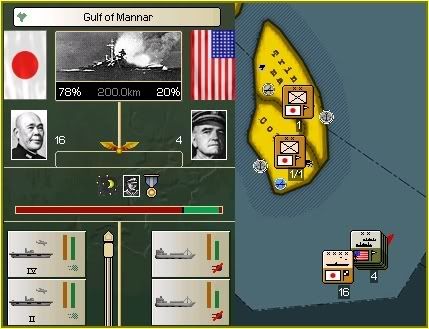
Daylight was still a few hours away and the Carriers were having their normal problems engaging at night. Yamamoto expected these enemy fleets to head for Rangoon after moving through the Gulf of Mannar as had been fairly common. They had other intentions.
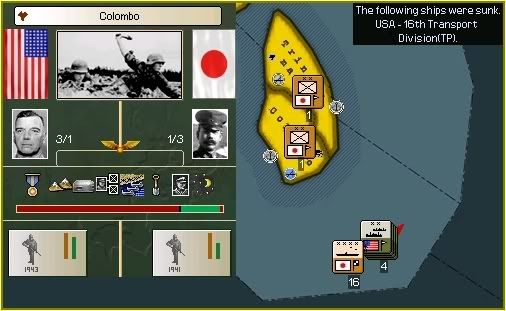
Three American ground divisions attempted to invade Colombo even though there was a major enemy fleet in the vacinity. The invasion was over by 2300 hours and one of the Transport Divisions had been sunk by IJN Junyo. Nagano ordered his fleet after the fleeing Transport ships to try and sink them and their cargo.
0800 January 25th 1945.
North China Army Headquarters. Jinghong, China.
The Japanese advance into Baoshan was approaching its completion but there was still time for another British division to try and halt this advance.
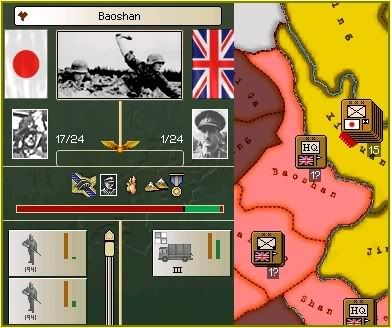
The battle would last a lot longer than Higashikuni wanted but victory was achieved by his tiring troops. The Imperial Japanese Air Force had done enough damage by now that it was deemed unlikely that any counter attack would occur once Japanese troops occupied Baoshan.
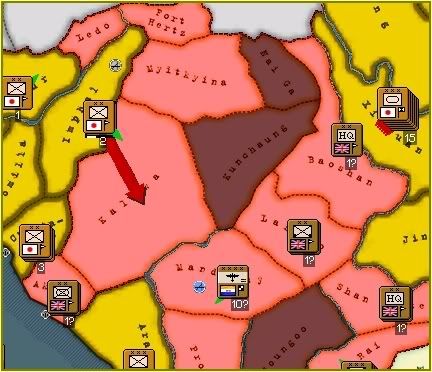
An advance in the west saw the capture of Imphal province and its small airbase. Allied aircraft had already left before the troops arrived but their main mission now was to isolate the British troops in Akyab by advancing into Kalewa. They would need until February 3rd to complete this latest forward move and the infantry would be in no condition to hold off any counter attack once they arrived.
2000 January 25th 1945.
BB Division 1 Flagship. IJN Yamashiro, Gulf of Martapan.
Carrier Group C had caught up with the fleeing American Transport fleet in the South Bay of Bengal as Yamamoto's lookouts reported sighting another United States Navy fleet in the Gulf of Martapan.
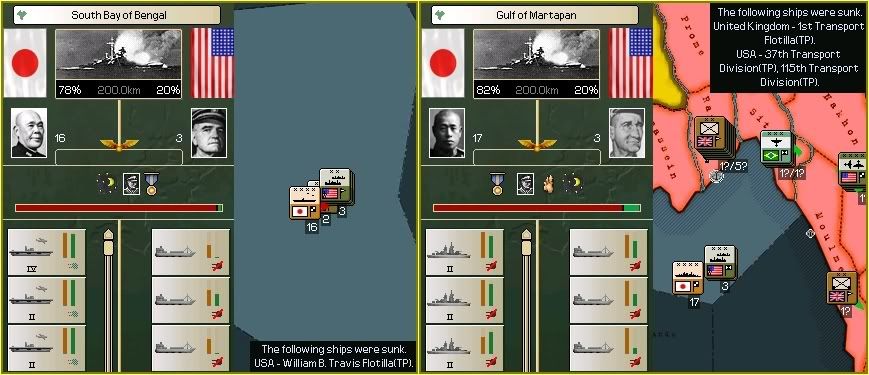
BB Division 1 did not really mind the darkness that had a bad effect on Carrier Group C. IJN Unryu's aircraft managed to sink one of the enemy Transport Divisions but the remainder would escape again.
The American fleet in the Gulf of Martapan was not so lucky as one British and two American Transport fleets sank. The Battlecruiser IJN Kongo would account for the British Flotilla as the Battleships IJN Hyuga and IJN Yamashiro sank the American ones. Apparently the British had asked for American assistance to try and either evacuate or reinforce Burma.
The American fleet in the Gulf of Martapan was not so lucky as one British and two American Transport fleets sank. The Battlecruiser IJN Kongo would account for the British Flotilla as the Battleships IJN Hyuga and IJN Yamashiro sank the American ones. Apparently the British had asked for American assistance to try and either evacuate or reinforce Burma.
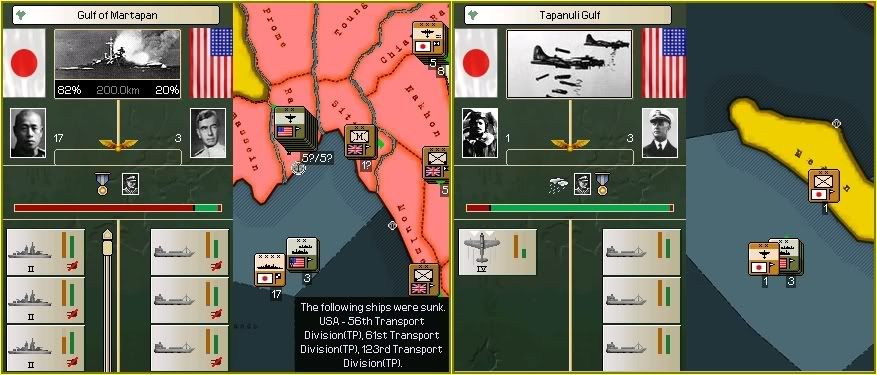
Seven hours after sinking the first fleet, BB Division 1 encountered another one trying to break the Rangoon blockade. The results were the same as all three Transport Divisions were sunk. IJN Hyuga would sink one with IJN Yamashiro accounting for the other two. Japanese spotter planes also reported that a third Transport fleet was also heading Yamamoto's way.

At 0700 hours on January 27th a small American fleet entered the North Mariana Trench and engaged the Japanese Submarines in the area. 2 Sensuikantai would be sunk by the 22nd Destroyer Division before Suekuni could open the distance and head for the safety of Saipan. He forwarded the latest spotting report to Ozawa who was quickly on the scene. There was a Transport fleet with these two Destroyer Divisions and it would need to be turned around before it could cause any trouble.

Carrier Group C arrived ahead of the Transport ships in the West Java Trench. This time it would be rain that prevented the Carriers from sinking anything. Nagano left these enemy ships for Koga to chase with BB Division 2 as he was clearly not destined to be the one to remove them.
1600 January 27th 1945.
North China Army Headquarters. Jinghong, China.
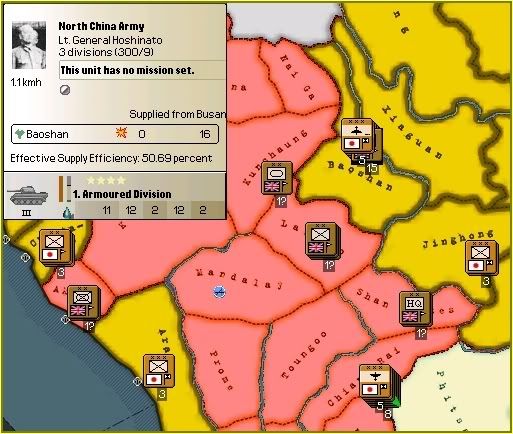
0000 January 28th 1945.
BB Division 1 Flagship. IJN Yamashiro, Gulf of Martapan.
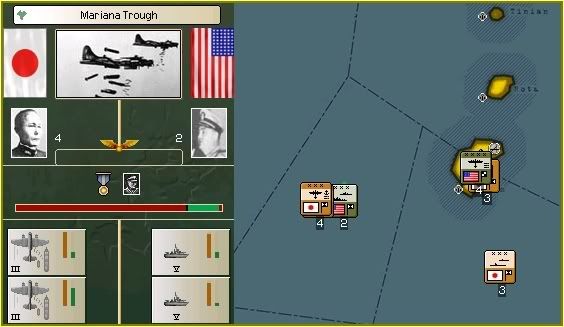


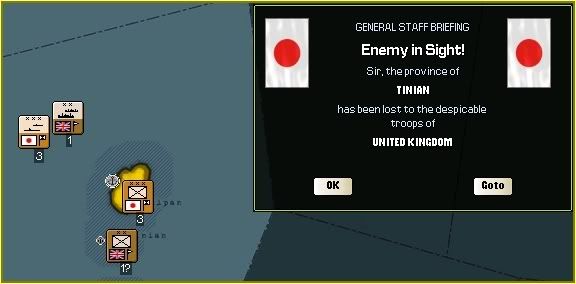
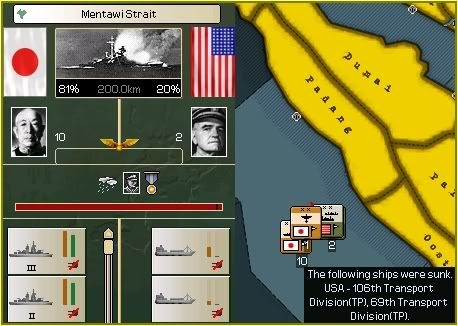
0600 January 29th 1945.
North China Army Headquarters. Jinghong, China.


1700 January 30th 1945.
BB Division 1 Flagship. IJN Yamashiro, Gulf of Martapan.
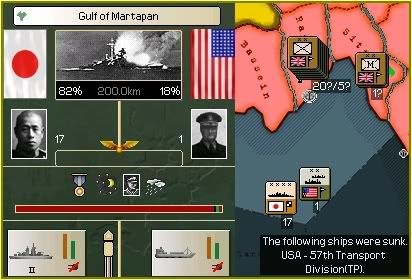
North China Army Headquarters. Jinghong, China.
Baoshan province had finally been retaken by Japanese forces spearheaded by Hoshinato's armour.

No counter attack was forthcoming from the British as the Dive bombers continued to rain destruction down from above. The single headquarters division, commanded by General Dohihara, headed north towards Nai Ga province while the remaining forces began to reorganise from their long march.
0000 January 28th 1945.
BB Division 1 Flagship. IJN Yamashiro, Gulf of Martapan.
The two escorting American Destroyer Divisions had left the Transport in the North Mariana Trench. Ozawa found the Destroyers first and would not make it to the Transport fleet today.

Suikuni ordered his Submarines back out to sea to find the Transports and sink them or force them to leave.

The Transport fleet that had been spotted a few days earlier arrived in the Gulf of Martapan at 0200 hours on January 28th. It promptly sank. IJN Hyuga would sink one Transport Division with IJN Yamashiro again taking the lions share with two.
What had been a costly exercise in futility from the Royal Navy's Merchant Marine was now turning into a similar one for the United States Merchant Marine.
What had been a costly exercise in futility from the Royal Navy's Merchant Marine was now turning into a similar one for the United States Merchant Marine.

Suikuni's Submarines caught the Transport fleet in the North Mariana Trench at 1900 hours.

At 2000 hours British troops occupied Tinian island. Yamamoto's defensive cordon had been breached, although it had occured at the least troublesome place possible. The Commander of the Japanese Pacific forces would largely ignore this problem unless an airbase or port facility happened to be sighted on the island. All three main islands were still very firmly under Japanese control and as long as that stuation remained he was not overly concerned.

BB Division 2 managed to finish off the Transport fleet that had escaped the Carriers in a brief battle in the Metawi Strait. IJN Nagato would sink one and the badly damaged Heavy Cruiser IJN Suzuya the other.
0600 January 29th 1945.
North China Army Headquarters. Jinghong, China.
Higashikuni wanted the British armoured division in Kunchuang removed before it could be repaired and dig in.

Japanese armour supported by aircraft would accomplish this mission for him. The chances of the enemy division reaching its new destination were remote with so many aircraft prowling overhead.

The five squadrons in the south had been reinforced by the five Dive bombers squadrons from the north. This more potent force had a lot of work to do in the mountains and jungles of the south.
1700 January 30th 1945.
BB Division 1 Flagship. IJN Yamashiro, Gulf of Martapan.
January was almost over and Yamamoto was content with progress. A very large number of enemy Transport ships had been sunk in the last thirty days and there were few signs of the pace slacking for the time being.

One more Transport Division wandered into the Gulf of Martapan in the early evening where it vanished with all hands to the guns of IJN Yamashiro.
Ah, the noose continues to tighten...
Do you plan on sealing the enemy escape by taking all of the coastal provinces or are you going to pinch them against the sea? Either way, I highly doubt that any of the enemy divisions will be able to escape. Nice work!
Do you plan on sealing the enemy escape by taking all of the coastal provinces or are you going to pinch them against the sea? Either way, I highly doubt that any of the enemy divisions will be able to escape. Nice work!
germanpeon said:Ah, the noose continues to tighten...
Do you plan on sealing the enemy escape by taking all of the coastal provinces or are you going to pinch them against the sea? Either way, I highly doubt that any of the enemy divisions will be able to escape. Nice work!
He'll probably take the coastal provinces first. It's easier to do with anphibious landings and it has the added benefit of cutting off their supplies.

